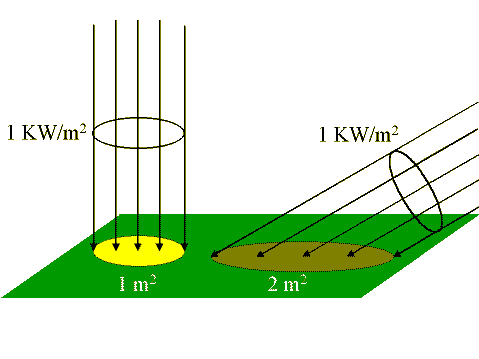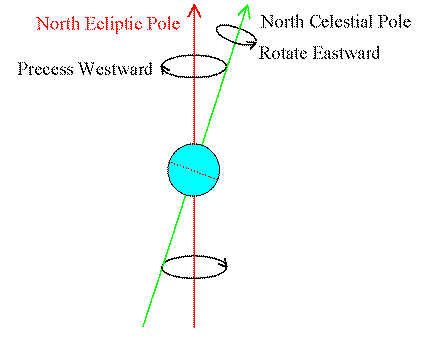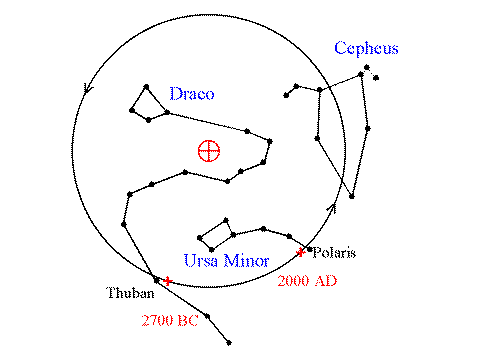Lecture 7: The Four Seasons
Key Ideas:
The Four Seasons
- Due to the tilt of the Earth's axis relative to the
plane of its orbit.
- NOT due to changes in the distance
of the Earth from the Sun!!!
The tilt of the Earth's axis affects
- The amount of direct sunlight (Insolation)
- The length of the day
Precession of the Equinoxes
The Obliquity of the Ecliptic
The Earth's rotation axis is tilted relative to the plane
of its orbit around the Sun:
- Tilt is about 23.5 degrees from perpendicular relative to the
Ecliptic Plane.
The Earth's axis points towards the same direction in space as we orbit
around the Sun:
- Currently points near Polaris.
- Changes slowly with time (as we'll see below)

(Click on the image to view at full scale
[Size: 19Kb])
The Equinoxes
In March & September:
- Axis is at right angles to the Earth-Sun line.
- The Sun is seen on the Celestial Equator.
- Day and Night are equal length (12 hours).
Vernal Equinox
- Occurs around March 21
- Northern Spring & Southern Autumn.
Autumnal Equinox
- Occurs around September 21
- Northern Autumn & Southern Spring.
Winter Solstice
Occurs around December 21:
- The Earth's northern axis is tilted away from the Sun.
- The Sun is at its maximum southern declination as seen in the sky
Northern Hemisphere Winter:
- The Sun is low in the sky.
- The day is shorter than the night
Southern Hemisphere Summer:
- The Sun is high in the sky.
- The day is longer than the night
Summer Solstice
Occurs around June 21:
- The Earth's northern axis is tilted towards from the Sun.
- The Sun is at its maximum northern declination as seen in the sky.
Northern Hemisphere Summer:
- The Sun is high in the sky.
- The day is longer than the night
Southern Hemisphere Winter:
- The Sun is low in the sky.
- The day is shorter than the night
The picture below summarizes the direction of the Sun at the four seasons:

(Click on the image to view at full scale
[Size: 43Kb])
Insolation
What matters for solar heating is how directly the rays of the sun hit
the ground:
Sun directly overhead (at Zenith):
- Maximum concentration of sunlight on the ground
- Approximately 1000 Watts/meter2 of heating.
Sun 30° above the Horizon:
- Sunlight spreads out over 2 meter2
- Get only 500 Watts/meter2 of heating.

(Click on the image to view at full scale
[Size: 14Kb])
The Earth-Sun Distance
The Earth's orbit is slightly elliptical, so that the Earth is closer
to the Sun at some times, and farther away at others.
Aphelion (greatest distance):
- Earth is 152.1 Million kilometers from the Sun
- Occurs in July (e.g., 2007 July 7)
Perihelion (closest approach):
- Earth is 147.1 Million kilometers from the Sun
- Occurs in January (e.g., 2008 Jan 3)
The difference in distances is about 5 Million kilometers. While this
seems like a lot (it is about 13 times the mean Earth-Moon distance),
overall it makes only a ~7% difference in the total amount of solar
radiation hitting the Earth.
Summer vs. Winter in Columbus
| June 21 (Summer Solstice) |
December 21 (Winter Solstice) |
| Sun's altitude at noon: 73.5° |
Sun's altitude at noon: 26.5° |
| Insolation: 960 W/m2 |
Insolation: 450 W/m2 |
| Average high/low temperature: 80/58° F |
Average high/low temperature: 39/25° F |
| Length of the Day: 15h |
Length of the Day: 9h |
| Distance from the Sun: 152 Million km |
Distance from the Sun: 147 Million km |
Hottest & Coldest Months:
- Hottest Month: July (average high/low 84/63° F)
- Coldest Month: January (average high/low 34/18° F)
Distance Doesn't Matter
The Earth is 5 Million kilometers closer to the Sun in
January than in July, yet January is the coldest month in the North!
As seen from Columbus:
- 7% more total solar radiation in January than July
- Insolation January is <50% what it is in July
Differences in seasonal insolation beat variations in solar radiation
due to differences in the Earth-Sun distance every time.
Seasonal temperature variations have
nothing to do with changes in the distance of the Earth from
the Sun.
Precession of the Equinoxes
The Earth's rotation axis slowly wobbles or precesses about the
Ecliptic Pole.

(Click on the image to view at full scale
[Size: 10Kb])
- Slow westward drift of the rotation axis
- Takes ~26,000 years to complete 1 circuit
- Amounts to ~50"/year, or 1 degree in 72 years.
- Discovered by Hipparchus of Nicaea (c. 150BC), but may have been known
to the Babylonians.
- Caused by tidal torques from the Moon & Sun.
The Age of Aquarius
Precession causes the Equinoxes & Solstices to drift westward over
time.
Vernal Equinox:
- Now in Pisces, will enter Aquarius in 2597 AD ("The
Age of Aquarius")
- 1 AD: in Aries ("First Point of Aries")
Summer Solstice:
- Now leaving Gemini & entering Taurus
- 1 AD: in Cancer ("Tropic of Cancer")
The "North Star"
Precession also changes which star is the northern pole star, if any,
over time.

(Click on the image to view at full scale
[Size: 10Kb])
2000 AD:
- Polaris is 0.75 degrees from the North Celestial Pole.
- Gets closest to the NCP in 2099.
2700 BC:
- NCP was near the star Thuban in Draco.
- Thuban was the pole star of the Old Kingdom of Egypt.
Return to [
Unit 2 Index
|
Astronomy 161 Main Page
]
Updated: 2007 September 17
Copyright ©
Richard W. Pogge, All Rights Reserved.




